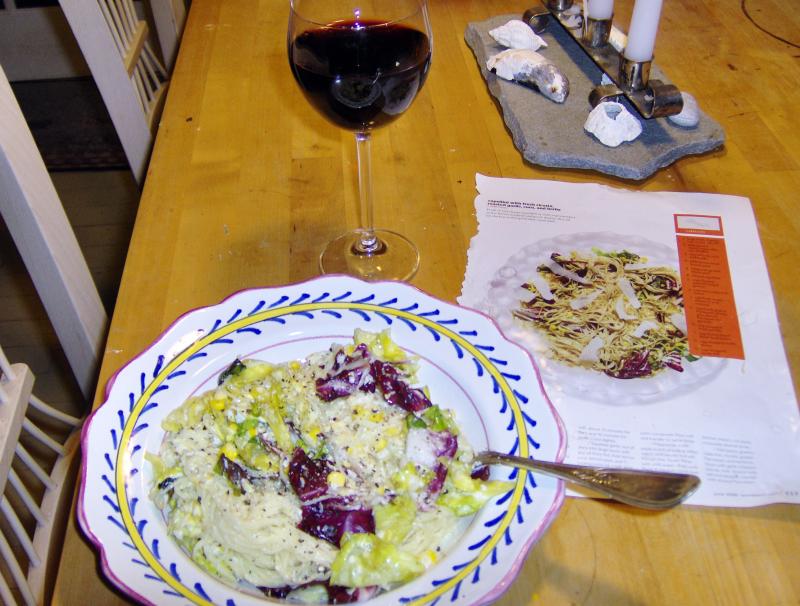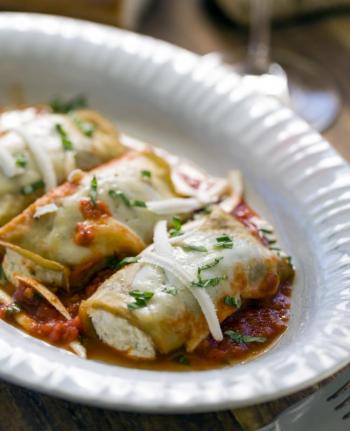Fresh ricotta: Luxuriously creamy
Little Miss Muffet
Sat on a tuffet,
Eating her curds and whey...
- most commonly attributed to Dr. Thomas Muffet, a notorious 16th century physician and entomologist
Did you ever wonder about the curds and whey Little Miss Muffet was eating? It was cottage cheese. Cottage cheese is curds and whey. You know what curds are. The liquid-y stuff in there is the whey.
Ricotta is similar to cottage cheese, but it's finely grained, thick and luxuriously creamy.
Whenever I buy a container of ricotta I usually end up throwing some away when I find it in the fridge a month later with a fine layer of green stuff growing on it. That's because its most common use, for me anyway, has been for lasagna.
But there are lots of other uses for it. Savory and sweet uses.
Ricotta can be used in many different ways, because although it’s big on smooth, creamy texture, it doesn’t exhibit a lot of flavor. Maybe because of that it's a common denominator in a lot of Italian cooking, which does exhibit a lot of flavor.
It's a nice accompaniment for rich aromatic tomato sauces when used as a filling in pasta dishes like lasagna, manicotti and ravioli. And blended with some type of sweetener it makes a dreamy filling for cannoli and blintzes.
Ricotta was originally made from sheep or goat’s milk, but these days it's mostly made with cow’s milk. At least here in the U.S.
Ports of Italy chef Fabrizio Ventricini said that most ricotta in Italy is still made from sheep's milk. “It's a lot richer,” he said. “Cow's milk ricotta is much more delicate and neutral.”
I love Italy, but after hearing that I'm just as happy I don't live there. I don’t like the idea of using sheep's milk. Or goat's milk. But I don’t like goat cheese either. A family friend in Cushing, the sculptor Blackie Langlais, used to have a pet billy goat. It always tried to butt me with its horns, and one day I made the mistake of patting its head. The smell it left on my hand was really gross, and it took a week to get rid of it. The first time I tasted goat cheese I swear it tasted like that billy goat smelled.
Sorry. We were talking about ricotta.
Chef Tony Bickford, of Little Village Bistro in Wiscasset, makes his own fresh ricotta used in his slow braised bolognese and cannoli. (By the way, cannoli is more than one cannolo — who knew?)
“I make it because I think it's superior to commercially made ricotta,” he said. “The recipe I use was taken from a basic recipe off the Internet, then tweaked to taste. It's a shining star in my bolognese dish and cannoli. Authentic Italian chefs would disagree with my recipe, as it isn't traditional, but I think everyone can agree that it is much smoother and tastier.”
Tony's recipe for 2 quarts ricotta:
1 gallon milk, 1 quart half and half, 1 quart heavy cream, 4 tsp. kosher salt.
Bring just to a boil (be sure to use a stainless steel heavy bottom pot) and remove from heat. Quickly stir in 1 cup vinegar. (He uses white balsamic, but said other vinegars will work as well.)
Let stand 15 minutes then strain through a chinois (metal strainer) or cheese cloth.
Bickford said the recipe can be altered depending on how you like it. “You can change the vinegar or add other ingredients to make it smoother or creamier.”
I wouldn’t change it. Have you eaten at Little Village Bistro?
Kathy Morrill of the State of Maine Cheese Company in Rockport sells fresh ricotta made nearby by local cheese maker Allison Lakin of Lakin's Gorges Cheese. I've heard hers is wicked good too.
Note to eggplant haters: Chef Ventricini makes an eggplant rollatini at Ports of Italy that I have heard called the best in the world. “It's eggplant for eggplant haters— that's how good it is,” said self-described food critic and former restaurant owner Matthew Stilphen.
“The key is in cooking the eggplant properly,” Ventricini said. “Eggplant has to be cooked all the way through for it to taste good.”
He said that the eggplant is thinly sliced, around 1/8” thick, dusted with flour, and fried in a good oil. “The frying gives it the flavor.” Then he mixes fresh ricotta with some herbs, parmesan and salt and pepper, rolls the eggplant around the filling, throws a little mozzerella on top and bakes them with a tomato sauce.
I'm going to attempt to make some ricotta this weekend. I have made a very pretty, fabulous salad that calls for ricotta a few times, and I want to try it with fresh, homemade ricotta. It's called 'Capellini with Fresh Ricotta, Roasted Garlic, Corn, and Herbs.'
I think I tore the recipe out of a Bon Appétit magazine in a doctor's office. Don't judge me. It was a long wait.




























